HISTORY OF THE CACTI COLLECTING IN SLOVENIA
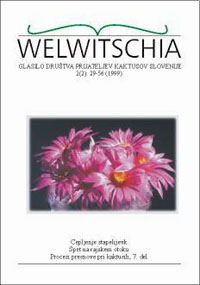 The number of Slovenian collectors of cacti increased considerably soon after WWI. Many were introduced to the hobby while working abroad. Undoubtedly the most influential among them was France Vardjan, the author of many articles and of the first Slovenian book dedicated to cacti. It would seem appropriate to write a few words about his life.
The number of Slovenian collectors of cacti increased considerably soon after WWI. Many were introduced to the hobby while working abroad. Undoubtedly the most influential among them was France Vardjan, the author of many articles and of the first Slovenian book dedicated to cacti. It would seem appropriate to write a few words about his life.
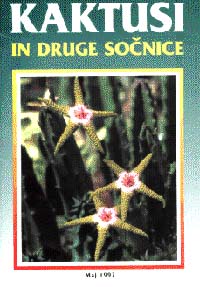 It was in the year 1921, while working with the Bayer pharmaceutical company in Leverkusen, Germany, that he was first introduced to the unusual plants. In the time, cacti were highly fashionable, yet only a few managed to keep them fit for long. France fell in love with them for the rest of his life. After returning home, his way somehow led to Љentjur, where he started from the scratch, for his plants were not allowed to be imported. After having been transferred to Breћice in 1928, the plants had to stay in Љentjur, for the principal of the school where he worked thought the plants were school's property. Again, he started a new collection. This time, friends from Zagreb helped, although he bought the majority in Austria. In 1941, during the German occupation, a greenhorn soldier took away the whole collection. He started for the fourth time in Leskovec near Krљko, built up a greenhouse, but kept mainly succulents other than cacti.
It was in the year 1921, while working with the Bayer pharmaceutical company in Leverkusen, Germany, that he was first introduced to the unusual plants. In the time, cacti were highly fashionable, yet only a few managed to keep them fit for long. France fell in love with them for the rest of his life. After returning home, his way somehow led to Љentjur, where he started from the scratch, for his plants were not allowed to be imported. After having been transferred to Breћice in 1928, the plants had to stay in Љentjur, for the principal of the school where he worked thought the plants were school's property. Again, he started a new collection. This time, friends from Zagreb helped, although he bought the majority in Austria. In 1941, during the German occupation, a greenhorn soldier took away the whole collection. He started for the fourth time in Leskovec near Krљko, built up a greenhouse, but kept mainly succulents other than cacti.
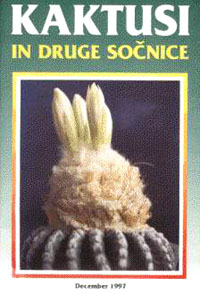 One night in 1986, during one of the famous temporary withdrawals of electric power, a phenomenon typical of the Yugoslav 'economic stabilization' periods, all the plants simply froze at the temperature of -17 °C. Since then, he concentrated mainly on collecting information for the book he was working on. The second book entitled simply 'Cacti' was thus printed in 1992, but it was only a somewhat reorganized first edition of 1966. We have to thank him, in particular, for making cacti so popular plants, although this happened only as late as the 60's, after the publication of his first book.
One night in 1986, during one of the famous temporary withdrawals of electric power, a phenomenon typical of the Yugoslav 'economic stabilization' periods, all the plants simply froze at the temperature of -17 °C. Since then, he concentrated mainly on collecting information for the book he was working on. The second book entitled simply 'Cacti' was thus printed in 1992, but it was only a somewhat reorganized first edition of 1966. We have to thank him, in particular, for making cacti so popular plants, although this happened only as late as the 60's, after the publication of his first book.
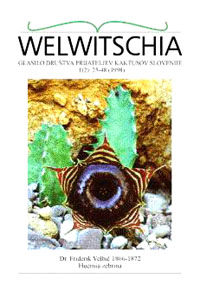 The more important collections were first formed in the Љtajerska region (Urbanek, Matuљ), while Rok Graљiи moved to Seиa near Portorose from Golnik in the Gorenjska region, built a conservatory there and became the first Slovenian large-scale grower and started a nursery.
The more important collections were first formed in the Љtajerska region (Urbanek, Matuљ), while Rok Graљiи moved to Seиa near Portorose from Golnik in the Gorenjska region, built a conservatory there and became the first Slovenian large-scale grower and started a nursery.
With the help from the "Moj mali svet" journal and the Union of horticultural societies of Slovenia a trip was then organized to Judendorf and Weiz near Graz, Austria, where two collections were to be visited. Many enthusiasts who didn't know each other met for the first time just then. A committee has been formed whose function was to prepare everything that was needed in order to form a society and met for the first time on December 10th 1970 in a bar, called "Julija". The first lecture took place the very next month in the Ljubljana Secondary Technical School where the meetings had been organized ever since. The lectures were given by eng. Engelbert Novak, the first president, Andrej Praprotnik, Janez Pogaиnik and Peter Jerin. Eng. Danica Honzak, an important initiative member, also took part. In the next year, the first issue of the Society's journal appeared. The journal is still published and distributed to all members.
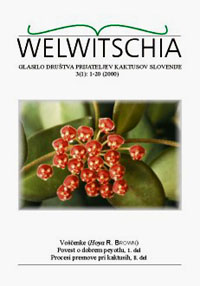 The Society was active at many Slovenian horticultural exhibitions. Since for a long time it was the only one of its kind, many members joined from then still our common state Yugoslavia, but mainly from Croatia. Similar societies from the neighboring countries had been contacted and especially with the Austrian Society the co-operation was exemplary. Until the economic crisis the number of members was steadily increasing. Then, for many of them the transport to Ljubljana became questionable. Besides, the Ljubljana horticultural show and exhibition gradually shifted the theme to the Ljubljana environment and health exhibition, so the society lost the prominent chance for promotion. Nevertheless, some bigger greenhouses were being built. None of the wealthier Europeans would be ashamed of some of the rarest species grown in these. Alas all of them are privately owned. Public gardens, such as the http://www.uni-lj.si/~bfbotanika/xvrt1.html or arboreta show little interest and have very limited collections, which is surprisingly different to some of the European botanical gardens.
The Society was active at many Slovenian horticultural exhibitions. Since for a long time it was the only one of its kind, many members joined from then still our common state Yugoslavia, but mainly from Croatia. Similar societies from the neighboring countries had been contacted and especially with the Austrian Society the co-operation was exemplary. Until the economic crisis the number of members was steadily increasing. Then, for many of them the transport to Ljubljana became questionable. Besides, the Ljubljana horticultural show and exhibition gradually shifted the theme to the Ljubljana environment and health exhibition, so the society lost the prominent chance for promotion. Nevertheless, some bigger greenhouses were being built. None of the wealthier Europeans would be ashamed of some of the rarest species grown in these. Alas all of them are privately owned. Public gardens, such as the http://www.uni-lj.si/~bfbotanika/xvrt1.html or arboreta show little interest and have very limited collections, which is surprisingly different to some of the European botanical gardens.
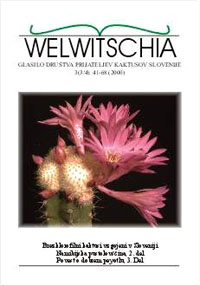 The Society nowadays organizes regular lectures, which may be attended by anyone interested in growing and studying cacti and other succulents, exotic or alpine plants. The meetings take place the second Friday in a month at 5 p.m. in the library of the Ljubljana Secondary School of Construction and Economics, Kardeljeva ploљиad 2, except in July and August. Regularly, plants, seeds, pots, substrate or pesticides can be purchased at low prices, while the most important thing is free: the experiences of other growers.
The Society nowadays organizes regular lectures, which may be attended by anyone interested in growing and studying cacti and other succulents, exotic or alpine plants. The meetings take place the second Friday in a month at 5 p.m. in the library of the Ljubljana Secondary School of Construction and Economics, Kardeljeva ploљиad 2, except in July and August. Regularly, plants, seeds, pots, substrate or pesticides can be purchased at low prices, while the most important thing is free: the experiences of other growers.
WELWITSCHIA is the official journal of the Friends of Cacti Society of Slovenia and was published from January 1972 till December 1997 as 'Kaktusi in druge soиnice'. Four issues are published per annum, in March, June, September and December. Authors of individual contributions are copyright owners and a permission must be obtained from them prior to reproduction in any form, either in part or as a whole. The journal welcomes contributions dealing with all aspects of botany or horticulture of cacti and other succulents, exotic and alpine plants. Please direct all inquiries regarding manuscript submission, society membership or advertising to the editor-in-chief, DPKS, Na trati 2, 4248 Lesce, Slovenia.





